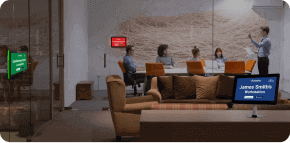Blog

Mastering Agility: How to Thrive in an Ever-Changing Workplace
In today’s rapidly changing business landscape, agility in the workplace has become a crucial trait for companies to possess. The ability to adapt quickly and efficiently to changes in the market and industry is essential for success. This article will explore the concept of one’s agility in the workplace and provide strategies for building an agile team that can thrive in an ever-changing environment.
Understanding Agility in the Workplace
A company’s agility in the workplace refers to its capability to respond rapidly and adapt to environmental changes. This means being able to pivot and adjust business strategies in response to market trends, customer needs, and emerging technologies.
In today’s fast-paced business world, agility is necessary for survival. Companies that need to be faster to adapt to changes risk falling behind their competitors and losing their competitive edge.
Examples of agile companies include Amazon, Google, and Facebook. The agility of these companies to pivot swiftly in response to shifting market conditions and evolving customer needs has been the key driver of their success.
Developing Agile Mindset
To build an agile team, it is essential to cultivate an agile mindset. This means fostering a culture that values flexibility, adaptability, and innovation.
Traits of an agile mindset include:
- Embracing Change: Being open to change and willing to adapt to new circumstances is crucial for companies to stay competitive and thrive in an ever-changing business environment.
- Willingness To Take Risks: Taking calculated risks and being willing to try new things is necessary for innovation and growth, as well as for taking advantage of opportunities.
- Ability to Work in a Fast-paced Environment: In today’s fast-paced business world, the ability to work quickly and efficiently is essential for success.
- Openness to New Ideas and Perspectives: Being open to new ideas and perspectives fosters creativity and innovation, which can help companies stay ahead of the curve.
- Strong Problem-solving Skills: The ability to think critically and solve problems quickly and effectively is essential for navigating challenges and seizing opportunities.
To cultivate an agile mindset in oneself and one’s team, it is vital to provide opportunities for learning and growth. Companies can do this through training programs, mentoring, and coaching.
The benefits of having an agile mindset include the following:
- Increased Innovation: An agile mindset fosters creativity, risk-taking, and openness to new ideas, leading to increased innovation, which is crucial for staying ahead of the competition and driving growth.
- Improved Problem-Solving Skills: Agile thinkers are skilled at finding solutions to complex problems, often through collaboration and experimentation, leading to improved decision-making and problem-solving across the organization.
- Greater Adaptability to Change: An agile mindset helps individuals and teams quickly adjust to changing circumstances, allowing them to pivot in response to new opportunities or challenges.
- Improved Teamwork and Collaboration: Agile thinking encourages collaboration, communication, and cross-functional teamwork, leading to more efficient and effective work processes and stronger relationships among team members.
- Increased Job Satisfaction: Employees with an agile mindset are often more engaged in their work. They are empowered to take ownership of their roles and contribute to the organization’s success. As a result, this could lead to a boost in employee job satisfaction, leading to an increase in both retention rates and overall productivity levels.
Strategies for Building Agility in the Workplace
To build an agile team, it is essential to implement strategies that promote flexibility and adaptability. Here are some strategies for building agility in the workplace:
#1. Flexible Work Arrangements and Their Benefits
Offering flexible work arrangements can foster agility in the workplace as it allows employees to customize their work schedule and environment to suit their needs and preferences better. This can increase productivity and job satisfaction and reduce stress and burnout.
#2. Developing Cross-functional Teams and Skills
When individuals with diverse skills and perspectives come together to work towards a common goal, cross-functional teams are formed. This can promote innovation and creativity by encouraging employees to think outside their usual roles and responsibilities.
#3. Encouraging Experimentation and Risk-taking
Encouraging experimentation and risk-taking can promote agility by fostering a culture of innovation and creativity. Organizations can do this through pilot projects, hackathons, and other initiatives allowing employees to test new ideas and approaches.
#4. Emphasizing Communication and Collaboration
Building an agile team requires effective communication and collaboration, which you can achieve through initiatives such as regular team meetings and open-door policies that promote transparency and openness.
Overcoming Obstacles to Agility
There are several common challenges to agility in the workplace, including:
- Resistance to change
- Lack of resources
- Lack of buy-in from management
- Lack of clear goals and objectives
To overcome these challenges, it is crucial to involve employees in the change process, provide the necessary resources and support, and communicate the benefits of agility to all stakeholders.
Unlocking Business Success through Workplace Agility
In today’s fast-paced business world, companies must be able to adapt to changing market conditions, technological advancements, and customer needs to stay competitive. This means that agility in the workplace is no longer a nice-to-have trait but a necessary one.
In addition to agility, workplace security is a critical consideration for any modern organization. With the rise of collaborative office spaces through innovative software such as DeskFlex, it’s becoming increasingly important for companies to implement strong measures to ensure the safety and security of their employees and assets. One such measure is the implementation of room names, which can help to prevent unauthorized access to sensitive areas within the workplace.
Bottom Line
When designing an agile office space, it’s essential to consider your team’s unique needs and work. For instance, promoting agility and productivity can be achieved by creating a flexible layout that people can easily reconfigure to accommodate changing needs. Additionally, incorporating elements like standing desks and ergonomic chairs can help to improve employee health and well-being, further enhancing productivity and agility.
Another crucial aspect of workplace security is implementing protocols and procedures that protect against internal and external threats. This might include measures like identity verification, access controls, and security cameras. In addition, training employees on best practices for maintaining office security can mitigate the risk of security breaches.
Ultimately, building an agile and secure workplace requires a comprehensive approach that considers a range of factors, from room design to security protocols. By prioritizing agility and security in the workplace, companies can position themselves for success in an ever-changing business landscape.















































 Support
Support  Demo
Demo  Blog
Blog